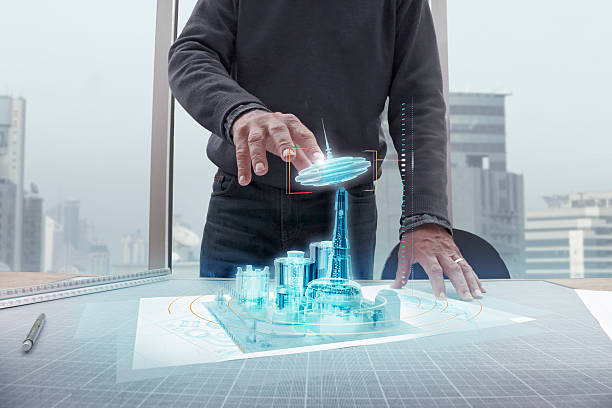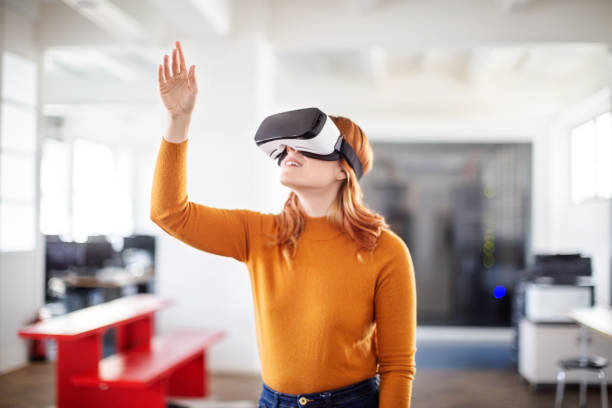Quote:-
“Augmented reality will change how we interact with the world, the same way the internet has changed how we interact with information.”
– Tim Cook, CEO of Apple Inc.
Table of Contents
1. Introduction to Augmented Reality
Augmented Reality (AR) is a technology that enables the integration of digital information with the real world environment. This means that users can experience a blend of the physical world and computer-generated elements, such as images, sounds, and other sensory inputs, through a variety of devices like smartphones, tablets, and AR headsets. Augmented Reality has the potential to revolutionize the way we interact with the world around us, by enhancing our perception of reality and providing new opportunities for education, entertainment, marketing, and more. In this guide, we will explore the fundamentals of Augmented Reality, its various types, applications, advantages and challenges, as well as its future prospects.
In more simpler terms
Augmented Reality (AR) is like magic glasses that you can wear on your eyes. These glasses can show you things that are not really there in real life. For example, you can look at a book and see pictures that come to life, or you can look at a toy and see it moving like a real animal. It’s like adding cool stuff to things you can see in the real world. With AR, you can have lots of fun and learn new things in a really cool way!

2. How Does Augmented Reality Work?
Augmented Reality works by combining digital information with the user’s real-world environment. The process involves three main components: input, processing, and output.
Input: The input for Augmented Reality can come from a variety of sources, including cameras, sensors, GPS, and other devices that can capture the user’s surroundings.
Processing: Once the input has been collected, it is processed using special software that analyzes the data and determines how to augment the user’s environment. This includes identifying objects and their locations, tracking the user’s movements, and rendering 3D models.
Output: Finally, the processed information is outputted to the user, usually through a display such as a smartphone screen, tablet, or AR headset. This output can take the form of 2D or 3D images, audio, or other sensory feedback, which is overlaid onto the real-world environment in real-time.
In simpler terms, Augmented Reality works by using technology to overlay digital information onto the user’s physical environment, creating an enhanced experience that blends the virtual and real worlds together. The end result is an interactive and immersive experience that can be used for a variety of purposes, including gaming, education, advertising, and more.
3. How to exemplify augmented reality?
One popular example of Augmented Reality is the mobile game Pokemon Go. In this game, players use their smartphones to navigate the real world and capture digital Pokemon characters that are superimposed onto the real-world environment. The game uses GPS and camera technology to identify the player’s location and overlay the Pokemon characters onto the real-world surroundings. Players can also interact with these characters by throwing virtual Pokeballs at them and engaging in battles with other players. To know more about Pokemon Go to: https://pokemongolive.com/
Another example of Augmented Reality is the Ikea Place app, which allows users to see how furniture would look in their homes before purchasing it. The app uses the camera on a smartphone or tablet to scan the user’s room, and then places 3D models of furniture into the space, allowing users to see how it would look and fit in their home. Ikea Place can be accessed from: https://www.ikea.com/us/en/customer-service/ikea-place/
Overall, Augmented Reality is a versatile technology that can be used for many different purposes, from entertainment and gaming to practical applications like interior design and education.
4. How augmented reality differs from Virtual Reality?
Augmented Reality (AR) and Virtual Reality (VR) are two related but distinct technologies. AR is a technology that adds a digital layer to the real world, while VR creates a completely virtual environment.
To illustrate the difference between AR and VR, consider the following example:
Imagine you are in a room with a table, a chair, and a lamp. With AR technology, you can wear special glasses that superimpose computer-generated images onto the real world. For example, you could see a digital tiger walking across the table or a cartoon character sitting on the chair. These digital objects are integrated into the real world and appear to interact with it.

On the other hand, with VR technology, you would wear a headset that completely immerses you in a virtual environment. You would not be able to see the real world around you, only the computer-generated environment created by the VR system. For example, you could be in a virtual forest, flying through the air, or exploring a virtual city.

So, the main difference between AR and VR is that AR adds a digital layer to the real world, while VR creates a completely digital world. To know about Virtual reality please follow the link https://amateurs.co.in/explore-the-transformative-power-of-virtual-reality/
5. Types of Augmented Reality
a. Marker-based AR:
Marker-based Augmented Reality uses predefined markers or patterns, such as QR codes or images, to trigger the display of digital content. The software recognizes the marker and overlays the digital content onto it. This type of AR is often used in advertising, education, and entertainment.
b. Marker-less AR:
Markerless Augmented Reality, also known as location-based AR, uses GPS, compass, or other sensors to determine the user’s location and orientation, and then overlays digital content onto the real-world environment without the need for predefined markers. This type of AR is commonly used in navigation apps, tourism, and outdoor games.
c. Projection-based AR:
Projection-based Augmented Reality projects digital content onto real-world surfaces, such as walls, floors, or objects, using projectors. The content can be interactive, and users can interact with it using their hands or other devices. This type of AR is often used in museums, exhibitions, and live events.
d. Superimposition-based AR:
Superimposition-based Augmented Reality replaces a part or the entire view of the real-world environment with digital content. The software uses sensors to identify the real-world objects and replaces them with virtual ones, creating an immersive experience. This type of AR is commonly used in the film and entertainment industry.
e. Outlining-based AR:
Outlining-based Augmented Reality uses edge detection and image recognition technologies to create a digital outline or contour of real-world objects, allowing the user to see and interact with them in a new way. This type of AR is commonly used in product design, industrial training, and maintenance.
Each type of Augmented Reality has its own strengths and limitations, and choosing the right type depends on the specific use case and the desired user experience.
6. Applications of Augmented Reality
a. Gaming and Entertainment:
One of the most popular applications of Augmented Reality is gaming and entertainment. Augmented Reality games, such as Pokemon Go, allow players to interact with digital characters and objects in the real world. AR can also be used in live events, concerts, and theme parks to create immersive experiences.
b. Education and Training:
Augmented Reality can enhance the learning experience by providing interactive and engaging content that makes it easier to understand complex concepts. AR can be used in textbooks, museums, and training programs to create realistic simulations and visualizations.
c. Advertising and Marketing:
Augmented Reality can be used in advertising and marketing campaigns to create interactive and engaging experiences for customers. AR can be used to showcase products, allow customers to try on clothing virtually, or provide additional information about products.
d. Healthcare and Medicine:
Augmented Reality can be used in healthcare and medicine to provide medical professionals with enhanced visualization and training tools. AR can be used to provide surgeons with real-time information during surgeries, help patients visualize their medical conditions, and improve the accuracy of medical procedures.
e. Manufacturing and Design:
Augmented Reality can be used in manufacturing and design to visualize and test products in a virtual environment. AR can help engineers and designers to create and test new products, visualize assembly processes, and identify potential problems before they occur.
Overall, Augmented Reality has numerous applications across various industries, providing unique opportunities for businesses to enhance customer experiences, improve productivity, and drive innovation.
7. How to differentiate applicability or utility of AR and VR?
Augmented Reality (AR) and Virtual Reality (VR) have different applications and utility based on their unique characteristics. Here are some key differences in their applicability:
- Real-world interaction: AR enhances the real world by adding digital overlays, while VR creates a completely virtual world. Therefore, AR is well-suited for applications where users need to interact with the real world and also access additional digital information or features. For example, AR is used in mobile apps that allow users to visualize furniture in their homes before making a purchase. On the other hand, VR is useful for applications that require users to experience a completely different environment, such as training simulations, gaming, or virtual tours.
- Mobility and flexibility: AR is typically used on mobile devices, such as smartphones and tablets, which allows for greater mobility and flexibility. It can be used in a variety of settings, such as outdoor environments, museums, and stores. On the other hand, VR is typically used in a stationary setting, such as a dedicated VR room or an office, and requires specialized equipment like headsets and controllers.
- Cost: AR is generally more affordable than VR because it can be implemented on existing mobile devices. VR requires dedicated hardware and software, which can be expensive. Therefore, AR is more accessible to a wider range of users and applications.
- User experience: AR provides a more natural user experience because it integrates digital information with the real world, allowing users to interact with both simultaneously. VR, on the other hand, can provide a more immersive experience by completely removing the user from the real world and placing them in a virtual environment.
In summary, AR is best suited for applications where users need to interact with the real world while accessing additional digital information, and where mobility and flexibility are important. VR is best suited for applications that require users to experience a completely different environment and can provide a more immersive experience.
8. Advantages and Challenges of Augmented Reality
a. Advantages of Augmented Reality:
- Enhanced user experience: Augmented Reality provides an immersive and interactive experience for users, making it easier to understand complex concepts and engage with digital content.
- Improved visualization: AR can enhance visualization and make it easier to see and interact with real-world objects in new and innovative ways.
- Increased productivity: AR can help businesses improve productivity by providing employees with real-time information, training tools, and simulations.
- Reduced costs: AR can help businesses reduce costs by providing virtual environments for training and testing, eliminating the need for physical equipment and materials.
- New revenue opportunities: AR can provide businesses with new revenue opportunities by creating unique and engaging experiences for customers, such as AR-based advertising and gaming.
b. Challenges of Augmented Reality:
Technical limitations: AR technology is still in its early stages, and there are technical limitations, such as hardware requirements, processing power, and battery life, that can affect the performance of AR applications.
- Lack of standardization: There is currently a lack of standardization in AR technology, making it difficult to create cross-platform AR applications and ensuring compatibility across different devices.
- Privacy and security concerns: AR applications may collect personal data, and there is a risk of data breaches and security threats, which can affect the user’s privacy and security.
- User adoption: AR technology is still relatively new, and there may be a lack of awareness and understanding among users, which can affect the adoption of AR applications.
- Design and development complexity: AR applications require a unique approach to design and development, which can be complex and time-consuming, requiring specialized skills and knowledge.
9. Future of Augmented Reality
The future of Augmented Reality (AR) is exciting, as the technology continues to evolve and improve, creating new opportunities for businesses and consumers alike. Here are some potential developments that could shape the future of AR:
- Advancements in hardware: As hardware technology continues to improve, AR devices could become smaller, more lightweight, and more powerful, making them more accessible and practical for everyday use.
- Integration with AI and machine learning: AR applications could be enhanced with AI and machine learning algorithms, allowing for more intelligent and personalized experiences.
- Expansion into new industries: AR is already being used in a variety of industries, but there is potential for it to be integrated into even more industries, such as construction, transportation, and retail.
- Standardization and interoperability: As the use of AR becomes more widespread, there will be a need for standardization and interoperability, making it easier to create cross-platform applications and ensure compatibility across different devices.
- Improved user interfaces: As AR applications become more common, there will be a need for more intuitive and user-friendly interfaces, making it easier for people to interact with AR content.
Overall, the future of AR is promising, with the potential to transform the way we interact with digital content and the world around us. As the technology continues to advance, we can expect to see new and innovative applications that will change the way we live and work.
10. Conclusion
In conclusion, Augmented Reality (AR) has become an increasingly popular technology that is transforming the way we interact with digital content and the world around us. AR has a wide range of applications in industries such as gaming and entertainment, education and training, healthcare, advertising, and manufacturing.
The technology is still in its early stages, and there are challenges to be overcome, such as technical limitations, lack of standardization, privacy concerns, and user adoption. However, with continued advancements in hardware, AI integration, and user interfaces, the future of AR is exciting, with the potential to revolutionize the way we live and work. AR has the potential to enhance user experiences, improve visualization, increase productivity, reduce costs, and create new revenue opportunities. As AR technology continues to evolve and improve, we can expect to see even more innovative and immersive applications in the years to come.
Resources:-
AR Insider: https://arinsider.co/
Next Reality: https://next.reality.news/
Augmented Reality for Enterprise Alliance (AREA): https://thearea.org/
AR Post: https://arpost.co/
Augmented.org: https://augmented.org/

[…] Augmented Reality (AR) is when computer-generated images or information are added to the real world, making it look like the virtual object is in the real world. For example, Snapchat filters, where you can see a virtual object on your face, is a type of Augmented Reality. To know about augmented Reality please the link https://amateurs.co.in/experience-the-power-of-augmented-reality/ […]